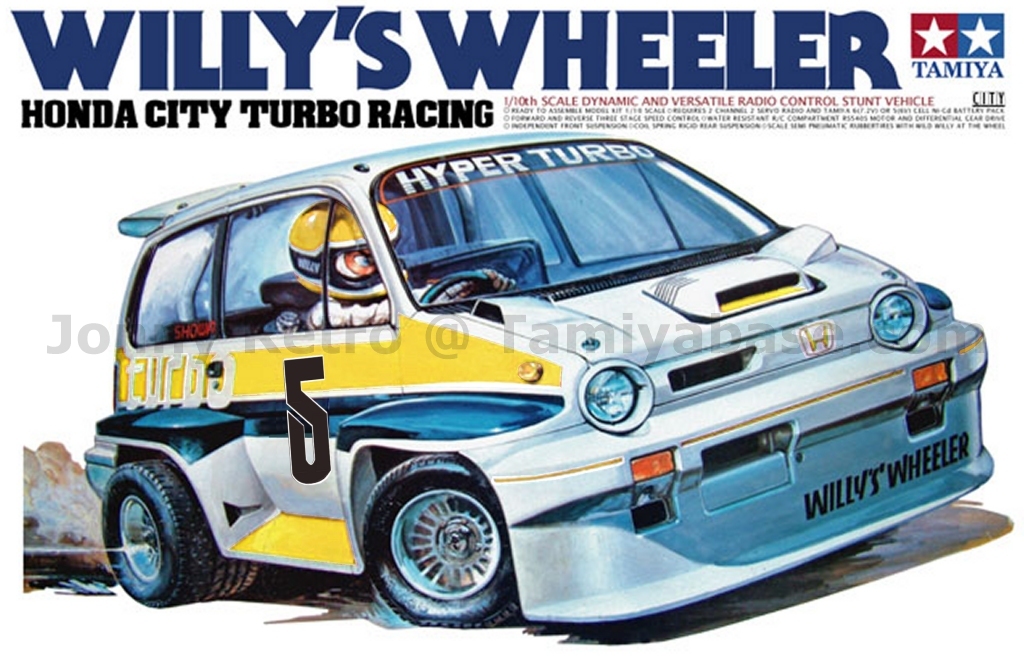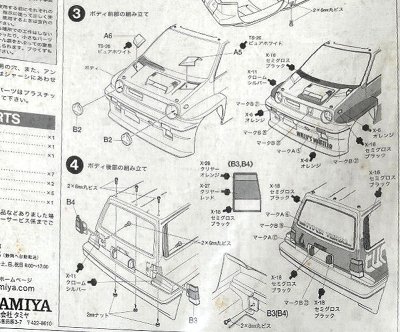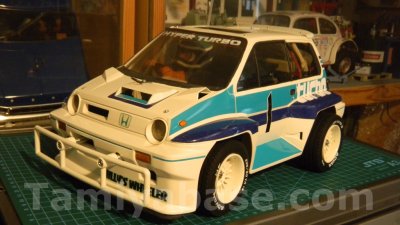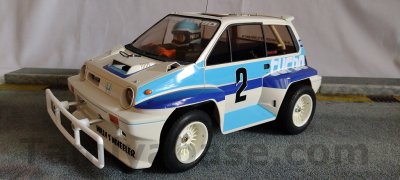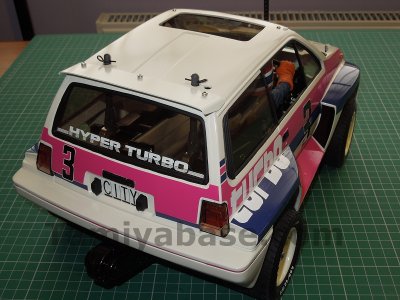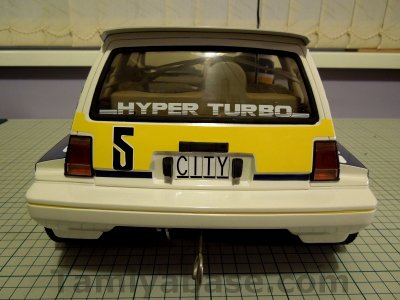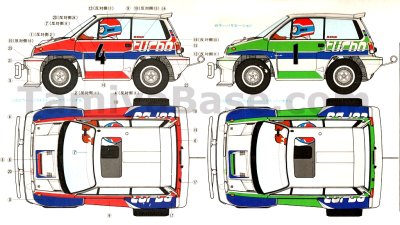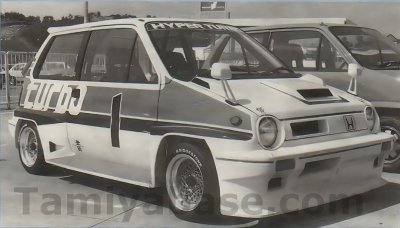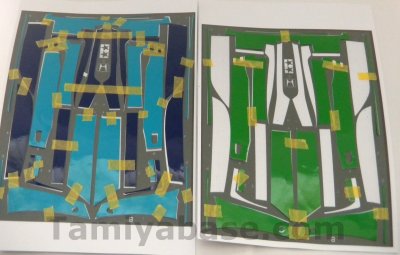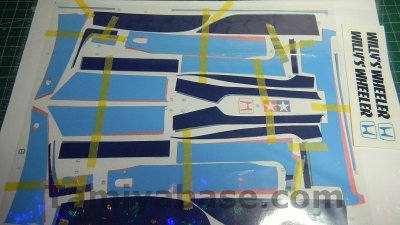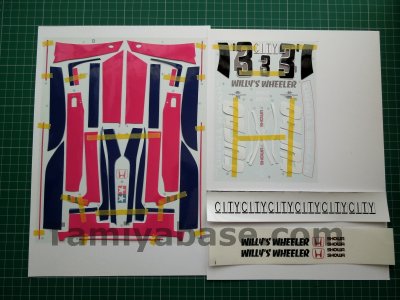Background on the Honda City Turbo II Bulldog Mugen R
When the Honda City (sold as the “Jazz” in Europe, and the “Fit” in the USA) came along in 1981, the standard models had a 1.2 litre inline 4-cylinder petrol engine producing 62 BHP, a 12.9 second 0-60, and a top speed of 88mph. That doesn’t sound like much, but for the time those figures were average for basic commuting/shopping trolley cars – although many got a higher top speed thanks to slightly less boxy designs.
Many other versions were available, including a convertible, “R” and economy versions, including City Turbo in 1982, with a more impressive 99 BHP, 8.6 second 0-60, and quite scary 111mph top speed. The Turbo II “Bulldog” got wider, slightly more power (108BHP) and torque, but a lower top speed of 108mph.
Peak silliness was achieved with the Mugen R (Racing) version of the Turbo II Bulldog, where the same engine, with many modifications including an intercooler, upped power to at least 138 BHP, which was delivered through nine” wide front tyres.
Notes on RC Releases
Willy's Wheeler (1983)
The Tamiya Willy’s Wheeler has an official (Japanese) release date of the 30th of August 1983. Re-using the Wild Willy chassis, albeit with smaller wheels and different gearing was a bonkers choice for a front engine, FWD car, but Tamiya and importers such as RiKO in the UK really leant into it, marketing it as a city going ride for the “Willy” character, putting in his second appearance at the time, in a modified form from the Wild Willy.
The head screwing together was no doubt meant to be an improvement but left an unrealistic hole and made the halves even more difficult to line up, even with glue. The driver’s body has been since labelled as the “torso” type, being much less complete to fit in the smaller space.
If sales on eBay are an indication of sales at the time, then it was outsold by the Wild Willy by something like a 4 to 1 ratio. Still, there seem to be more surviving Wheelers than Quattros (on an extended version of the chassis), and way more than the Opel Ascona Rally.
Tamiya City Turbo Racing Bodyset (2000)
Tamiya sold a “Honda City Turbo Racing” bagged body set in the year 2000, my understanding that this was at just one Japanese model show. In most regards it appears to be the same as the body as sold with the Willy’s Wheeler, but it doesn’t include the aluminium rear wing, and the instruction sheet shows the surplus holes are blanked off with screws. The decal sheet shows the year 2000 in small print on the bottom left corner.
Tamiya Honda City Turbo (2015)
The Tamiya Honda City Turbo arrived on the 1st of April 2015, having the same body (but with extra holes for the rear body posts), wheels and tyres as the Wheeler on the WR-02C chassis (as used on the Wild Willy 2). Wheel arch fit around the front wheels was even worse than the original release, and underside of the front of the body tended to drag on the ground, even before hitting a bump, necessitating some builder revisions straight out of the box.
Early drivers’ sprues sold as spares (and some of the very earliest kits, by repute) still had the rollbar loop from the Wheeler, even if it didn’t have the metal core it was still very handy for restoring damaged and/or incomplete Wheelers.
I’m hoping for a re-release of the City Turbo, prices for unbuilt examples have reached three times the original purchase price on eBay, and as Tamiya don’t get to see any of that extra, you would think it would make good business sense to put it back in production.
ABC Hobby Honda City Turbo II Bodies (current)
ABC Hobby make polycarbonate Honda City Turbo II bodies in at least two versions, one includes vacformed light buckets for FWD M-class chassis such as the Tamiya M-03L and M-05L. This is a smaller, more correctly proportioned rendering of the road spec, 108BHP car, not the Mugen R (Racing) 138BHP version the Tamiya cars are based on.
Hirobo Rock 'N' City (1983)
Hirobo released the Rock ‘n’ City - a Honda City body on their “44B” belt drive, 4-wheel drive buggy chassis in 1983*, so it’s possible that it came out before the Tamiya Willy’s Wheeler. From the bonnet (hood) vents and the wing type peak on the rear of the roof I think it must have the same inspiration as the Tamiya cars, but it looks quite different.
It has a very wide track (the wheels sticking out way past the body) and a wheelbase that doesn’t even attempt to keep the rear wheels in line with the arches. As far as realism goes, it’s even more out there than the Tamiya Wheeler.
* https://www.rcscrapyard.net/uk/hirobo-timeline.htm
Source of the Tamiya Colour Scheme
The 1:1 source of the Willy’s Wheeler colour scheme is often cited as being a Japanese racing series for female drivers*1, but the Tamiya boxart livery (and the alternatives) were based on cars that initially featured in a demonstration race supporting the Japanese F1 Grand Prix event at Suzuka in 1982, with the 5 cars being piloted by drivers who already were involved with F1, or later went on to drive in F1.
*1 I suspect this is due mostly to the number one result on YouTube being an event on a very wet Japanese track, where female drivers are racing cars with the same 1 (green), 2 (light blue), 5 (yellow) liveries, the “boxart” (red) with a number 6, and a 5th car (possibly #3, but no number is visible in the clip) in the dark pink/light Fuchsia scheme.
The next clip in the same video (https://www.youtube.com/watch?v=PUByR5uJZAA) shows a 10-car race where Hot Wheels got most of their liveries for their Honda City Turbos**2. Later races show the field has grown to fifteen, then seventeen – none of which are in the initial 1-5 colours.
Legend has it the cars**2 were later due to be shipped to Australia but were destroyed when the Osaka warehouse storing them collapsed in an earthquake.
**2 the seventeen from the one-make series rather than the five from the initial demonstration race.
The Five Variants
All five variants of the car have the same white main body colour with accents in a dark (Navy) blue and a secondary colour, as detailed below:
|
Race Number |
Alt. Colour |
Driver |
Country |
F1 Career |
|
1 |
Green**3 |
Satoru Nakajima |
JPN |
1987-1991 |
|
2 |
Light/Sky Blue |
Jonathan Palmer |
GBR |
1982 (test), 1983-1989, 1989 (test) |
|
3 |
Dark Pink (Fuchsia?) |
Stefan Johansen |
SWE |
1980 (didn’t qualify), 1984-1991 |
|
4 |
Red |
Thierry Boutsen |
BEL |
1983 (but was a test driver prior to that) - 1993 |
|
5 |
Yellow |
Kenny Acheson |
GB(NI) |
1983-1984 |
Green or Teal?
**3 The #1 car is shown as a bright mid green on the Tamiya Willy’s Wheeler Body Set box. I once painted a helmet in X-28 Park Green and that is remarkably close.
Nb: note that the driver’s helmet is in the same red, white & blue livery as the #4 car, whereas I’ve swapped the red for the alternative colour.
The same green colour or thereabouts also featured on Panda Graphics’ (not sure of the spelling, might have had a X?) and MciRacing**4’s alternative set (although the numbers on both were incorrectly supplied as 4s).
However, the Ebbro 1:43 version - considered by many to be the peak of diecast reproduction for this model - looks distinctly more Teal like (blue green), and I’ve gone for a close match to that.
The #1 car is the one shown in the Willy’s Wheeler manual, but it’s printed in greyscale, so it doesn’t really help with identifying the precise shade of green.
It should also be said that the “teal” colour really doesn’t show up that well in my photos, and I really struggle to tell some shades of blue and green apart.
Even More Options?
In Tamiya’s promotional video for the Wild Willy and Willy’s Wheeler (e.g. https://www.youtube.com/watch?v=h1y9FlnbM_M), cars with other liveries are shown, but as the quality is so poor it’s a bit hard to say exactly what they are – one would appear to the #1 Green/white/blue livery (although the number is no visible). Later, a head-on shot shows the #4 (Red/white/blue) car out of control, the #1 (green/white/blue) car, one that appears to be all red (or possibly orange, possibly with a white stripe or at least white “turbo” graphics on the sides), and a blue car, possibly with a white side stripe or graphics, and a red lower skirt, possibly showing that Tamiya tried some other options out on actual 1:10 kits.
The #4 car (with red accents) is the one featured as “box art” on both the vintage Willy’s Wheeler and re-release/re-chassis Honda City Turbo. I’m just as hardwired for the Primacy Effect as anyone else (a cognitive bias where the first bit of information is the one most easily remembered, which would also seem to extend through which LP/novel/film by a particular artist or in a particular series you regard as the “best”, and onwards to any other area in life or art) so I can’t say that this colour scheme is actually best, but there’s no doubt it’s the most common. My first Wheeler bought BITD got the boxart (red) stickers, but my next one – some years into my return to RC in middle age – got hand cut #5 (yellow) alternatives.
The red boxart scheme – and the four close alternatives – are by no means the end of the possibilities though, the Wheeler/City Turbo. Provided they are well executed and are sympathetic to the Wheeler’s boxy shape, most other colours (and combinations) seem to work.
How To Do It
**4 MciRacing allow you to swap any colour for another for their prints. To my eyes, swapping Red to “Green” or “Teal”, “Peacock Blue” or possibly “Cyan Blue”, “Magenta” and “Yellow” could give the “correct” results – including the fine lines, and the lines around the windscreen topper and Honda logo, only messing up the small “Showa” sponsor decals, which personally I could live without. The racing numbers would be wrong, but as they’re separate on the decal sheet, you don’t have to use them.
I used a more DIY approach, using a scan of a decal sheet & mirroring parts where needed, then printing the results out. I stuck those printout on the back of sheets of self-adhesive vinyl in the relevant colours, then carefully cut out with scissors, a scalpel and even a belt punch for the hole for the door locks.
For the missing racing numbers, using the Ebbro diecasts as reference, I drew a version for the white outline, then a smaller version for the black digit. Resizing the two gave me smaller numbers for the rear and roof. This method does mean you end up having three layers of vinyl in places – stripes, white outline & black digit.
Once I got a plotter/cutter, I redrew the scanned shapes as a new layer, filled the shapes and split them into files for each colour required - dark blue, white, black, and choice of colour. That turned out to be way more time consuming than it sounds, but at least this way, if I ever get enough cars (Willy’s Wheelers or Honda City Turbos) for a full perm, I’ll save a bit of time on the cutting out :)
It’s not possible to make every decal required using this method, the small Showa and Mugen logos for example are best gleaned from a repro decal sheet or printed onto clear waterslide transfer sheet. I haven’t been able to reproduce the graduated nature of the “HYPER TURBO” text on the front and rear screens, but they look ok as whole letters, or again they can be taken from repro decal sheets.
__________________________
Written by TB member Jonny Retro



